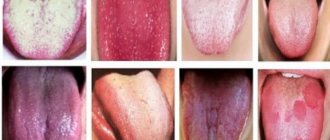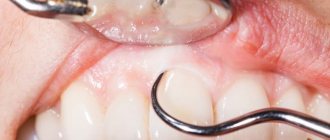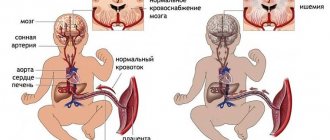Problem: for a consultation with the Dial-Dent speech therapist T.B. Zukor was contacted by a 22-year-old man. His wish: “We urgently need to trim the frenulum of the tongue! The surgeon needs a referral from a speech therapist to perform the operation!” The reason for this urgent treatment was unbearable pain in the tongue area when kissing!
Solution: myofunctional examination confirmed the need for frenuloplasty of the tongue (surgery to trim the frenulum of the tongue). The man received a referral for an operation, which was performed by surgeons at the clinic. Frenuloplasty of the tongue was successful, the pain was completely eliminated.
The speech therapist of the Family Dental T.B. talks about the short frenulum of the tongue, how to identify it, and what to do with it. Zukor in his article.
Short frenulum of the tongue - how to determine?
Symptoms of a tongue frenulum are usually identified by a speech therapist during a myofunctional examination. Most often, specialists (this can be attentive parents or the patient himself) observe the following symptoms:
- Limitation of tongue mobility; it is difficult for the patient to move the tongue out of the mouth and raise the tip of the tongue to the upper lip.
- The tip of the tongue bifurcates when you try to push it forward.
- The patient pronounces the sound L incorrectly, making it sound like V.
- Sometimes a short frenulum of the tongue brings purely everyday discomfort, as in the clinical case described above.
Signs of pathology
A congenital defect of the frenulum is detected by a number of signs. They are visible to the naked eye and are diagnosed by a doctor during the initial examination of the newborn.
The main one is the unusual shape of the tongue with the tip slightly pulled down. It looks a bit like a small heart.
There are secondary factors that manifest themselves during feeding in the baby and the mother:
- The baby smacks his lips and releases the nipple, which increases the duration of the feeding session and, in general, it becomes quite difficult to feed the baby.
- Without eating, the baby gains weight worse.
- Due to poor nutrition, colic occurs more often in a child. He regurgitates food.
- The pathology does not allow the newborn to hold the mother's breast correctly, which is why cracks and bite marks remain on the nipple, and less milk is produced.
If these symptoms appear, you should take a close look at the child.
Methods for eliminating a short frenulum of the tongue
A short frenulum of the tongue is corrected surgically. The most modern method is cutting the frenulum of the tongue with a laser, since there is less pain, the operation is almost bloodless, the wound is sterile and heals quickly.
Operations can be different:
- Frenuloplasty of the tongue is plastic surgery of the frenulum of the tongue with mobilization. Mobilization is the preparation of the edges of the wound for a screed by pulling the tongue forward and upward; flap formation is often used in plastic surgery. In most cases, frenuloplasty of the tongue is the most favorable way to lengthen the frenulum for both healing and restoration of the tongue.
- Frenulotomy is a dissection of the frenulum, usually done in the maternity hospital by simply cutting the frenulum without sutures.
- Frenulectomy - excision of the frenulum. During this operation, the doctor cuts the tissue wedge-shaped in several places, then applies sutures, but does not mobilize the tongue. This is a disadvantage of the method.
Obviously, each case is individual and the choice of method should be made by a specialist.
Table of contents
- For what reason does a frenulum defect form?
- Symptoms of congenital frenulum pathology
- Types of frenulum pathology
- Complications with frenulum defects
- How is a frenulum defect treated?
It is due to the presence of the lingual frenulum that a person has the ability to consume food, influence breathing and even control the tongue to speak. It is worth noting that problems often arise with the lingual ligament, since its structure is of considerable importance.
- Ideally, the membrane in the oral cavity should be approximately 3 cm in an adult, and at least 8 mm in children, which will be considered normal.
- The frenulum may vary from person to person in length, density, and degree of elasticity.
- If the structure of the ligament is correct, then it will not affect the mobility of the baby’s tongue.
For what reason does a frenulum defect form?
Dentists call frenulum pathology a congenital defect, which depends on several factors.
- Genetic inheritance. According to statistics, if one parent had a similar problem, then the probability of it occurring in the child is 50%.
- Violation of fetal development during the perinatal period. In other words, a congenital defect of the frenulum appears, which leads to abnormal cords, or in other words, the formation of connective tissues well supplied with blood fluid, which prevents the child from properly controlling the tongue.
There are a number of predisposing factors that can lead to such a defect.
- The emergence of the virus in the mother’s body during pregnancy, especially before childbirth.
- Impact of bad environment.
- Pregnancy after 35 years of age.
- Presence of intrauterine infection of the fetus.
- Presence of chronic somatic diseases.
- The occurrence of traumatic injury to the abdominal cavity before pregnancy.
Symptoms of congenital frenulum pathology
In order to diagnose pathology in the development of the frenulum and give indications for correction, you will need not only an examination by a dentist, but also the presence of obvious signs of such a problem. Namely:
- inability to move the tongue outside of the abnormal location;
- the presence of a bifurcation of the tip of the tongue, as well as the shape of the tongue in the form of a cup or groove, due to the fact that its base is tightly pressed to the bottom of the mouth;
- inability to lift and extend the tongue forward;
- touching the lips with the tongue only with its tip;
- the presence of a thin thread between the tongue and the base of the oral cavity when examining a baby.
Types of frenulum pathology
The frenulum defect can be partial or complete. The differences lie in the symptomatic picture.
In the first case, the ligament under the tongue is partially attached to the edge of the bone bed of the dental structure, and in appearance resembles an avascular transparent thin film. In this case, incomplete mobility of the tongue is diagnosed.
In the second case, the tongue is completely immobilized, since its entire length is chained to the base of the mouth. The lips are pressed very tightly against the teeth, and when examined by a specialist, the baby can roll his tongue into a tube, but inside the mouth, without pulling it out.
Complications with frenulum defects
Important: If the pathology of the frenulum is not corrected, then serious consequences are quite possible, which are much more difficult to eliminate.
- A slowdown in the development of the lower jaw and all adjacent bones becomes noticeable.
- An abnormal bite often occurs, in other words, an uneven dentition. There are two options - either too large gaps will form between the teeth, or vice versa - they will begin to move too tightly, which will cause distortion of their location.
Infants who have this pathology often have problems with breastfeeding.
- Due to the lack of full control of the tongue, a child from birth cannot consume breast milk, since he physically cannot grasp the nipple.
- During the feeding process, milk production in the mother's breast will not be stimulated.
- Due to a violation of the sucking function, feeding can be carried out for a long time, but this does not allow obtaining the required amount of milk and, as a result, the child has to be supplemented with artificial nutrition.
- Due to all of the above points, the child begins to develop a fear of feeding and manifests itself in the form of anxiety when hunger occurs. That is why experts recommend switching children completely to artificial nutrition.
If there are problems with the frenulum, nutrition is disrupted because:
- difficulty chewing food;
- difficulty swallowing foods;
- Inflammatory processes in the oral cavity can often occur, which occurs due to increased sensitivity of the mucous membrane.
The most serious consequence is considered to be speech impairment.
- When the time comes for gradual speech training, minor defects may be observed.
- Diction and word formation may be impaired, and even a lisp may be present.
- The child is unable to pronounce the upper lingual sound correctly.
- Problems appear at the age of 2-3 years.
- Maybe personal discomfort when talking, which leads to more silence from the child rather than communication.
Important: If you find such problems, you should immediately contact a specialist to eliminate it as early as possible.
How is a frenulum defect treated?
Doctors may use conservative treatment, which requires the use of articulation exercises. In some cases, this helps avoid surgery. The technique consists of stretching and training the articulatory apparatus.
In extreme cases, surgical correction or, in other words, frenulotomy is performed. This method is used if the defect causes serious problems for the baby. If the frenulum defect is partial, then it is simply trimmed a little, and if you have to deal with complete fusion of the tongue and oral cavity, then a serious operation is needed. During the procedure, the gums and lips are separated from each other, just like the lips are separated from the tongue.
Correction of the ligament under the tongue in newborns is required when:
- identifying problems with breastfeeding, for which plastic surgery of the congenital anomaly is performed by slightly cutting the frenulum;
- the absence of blood vessels and nerve endings in the frenulum under the tongue, which requires cutting the lingual ligament, and if the ligament has partially grown in, then the procedure will not cause problems and does not take much time to carry out;
- If a defect is identified immediately after birth, the procedure is carried out through the use of special dental scissors, which are used to trim the ligament in the first minutes of life, and to stop bleeding it is enough to simply apply it to the chest;
- detecting a problem in the first year of life, for which dental scissors or a radio wave scalpel are also used, with the additional use of local anesthesia.
In general, under the age of one year, the procedure will not take more than a few minutes, and complications do not arise after it. As a rule, after cutting the frenulum immediately after birth, improvements in breastfeeding are noticeable.
Correction of the lingual ligament during the period before school is carried out in a special way and with the presence of specific indicators
- At 2-3 years, a change occurs in the structure of the frenulum, as vessels begin to form in it. The ligament thickens and becomes fleshy. That is why frenuloplasty is performed under anesthesia, in a hospital, and it is necessary to apply sutures that will dissolve on their own.
- If a shortened frenulum is detected in a preschooler due to incorrect sound pronunciation, then this is organic dilalia, and not undergoing correction will lead to inaccurate diction in the future.
Important: In any case, if defects occur with the frenulum under the tongue, you should consult a dentist and speech therapist. This will help solve the problem at an early stage and avoid the serious consequences described earlier. The treatment is carried out without difficulty, quickly and efficiently, which eliminates the occurrence of stress in the child, regardless of his age category.
There is a type of correction through bloodless plastic surgery of the lingual ligament. The method appeared relatively recently, but is already very popular. The essence of the correction is:
- the absence of a detrimental effect on the general condition of the child during frenolotomy;
- carrying out the operation using a special laser device that does not cause discomfort;
- using not anesthesia, but an anesthetic in the form of a gel;
- easier postoperative period, unlike other methods of cutting the ligament, regardless of age and complexity of the problem.
Important: remember that the sooner the procedure is performed, the greater the likelihood of avoiding speech defects and other problems that can cause a lot of harm in adult life. The presence of incorrect diction and incorrect pronunciation of sounds has a very negative impact on learning, communication and even finding a suitable job.
For school-age children who have identified a problem such as pathology of the frenulum under the tongue, radical measures must be taken.
- In advanced cases, after the age of 5 years, frenuplasty must be performed as prescribed by the dentist, or in other words, a serious surgical intervention under general anesthesia, with sutures. If there are severe restrictions in the excursion of the tongue, as well as pronounced complications, for example, advanced pathology, the orthodontist or speech therapist will refer the child to a dental surgeon. The result of the procedure is the release of the tongue, but a properly observed rehabilitation period is required to eliminate the possibility of complications. In some cases, it may be necessary to correct uneven teeth.
- Surgery may be required for an adult with severe periodontal disease and speech defects.
- It is mandatory for children to visit a speech therapist so that speech can be corrected directly, since after the intervention of a doctor, speech normalization does not occur on its own.
Important: The presence of a short frenulum in a child is a serious problem that must be dealt with immediately, not by independent actions, but with the help of qualified specialists. According to statistics, those children whose frenulum was corrected in infancy are the best at restoring speech and getting rid of speech defects. Proper classes with a speech therapist help to completely eliminate the defect, but the participation of parents in the development of the child and, especially, correctional procedures is imperative.
Causes of the defect
The most common cause of the defect, provoking half of the cases, is a genetic predisposition and hereditary factor.
Another reason is the use of hormonal medications and antibiotics by a pregnant woman. Moreover, the most dangerous period is the first trimester of gestation. This factor also influences the formation of other oral pathologies.
A certain motivating factor in the formation of pathology can be late pregnancy - after 35 years, but this is not at all necessary and has a negligible effect.
The exact causes of this problem have not been studied, so sometimes it appears even without obvious reasons.
What can pathology threaten and interfere with?
The anomaly harms not only the baby, but also the grown child.
Among the negative consequences, professionals highlight the most dangerous:
- A short frenulum greatly affects the development of the baby and causes a lot of problems for an older child, so it needs to be eliminated as soon as possible
improper breastfeeding and weight loss;
- disruption of the digestive system and teeth due to insufficient chewing;
- speech defects, disturbances in the position of masticatory organs;
- snore;
- breathing pathologies;
- insomnia.
In general, despite the painlessness and absence of a threat to life, a short frenulum greatly affects the development of the baby and causes a lot of problems for an older child, so it needs to be eliminated as soon as possible.
Problems with breastfeeding
This consequence of the anomaly concerns not only the health of the baby, but also his mother. Therefore, we should talk about this in more detail.
The baby's anatomy is designed in such a way that he actively uses his tongue when latching on to the nipple. However, the short frenulum does not allow him to use this organ, so the gums and lips come into play.
Note! This causes a lot of stress on the chewing apparatus, which makes the baby tired. His jaw may tighten, and while feeding he will cling and bite the breast strongly, causing discomfort to the mother.
After such feeding, the nipple becomes as if pinched or beveled, like the edge of a purchased lipstick. Due to increased friction, a watery bubble forms on its front part, and sometimes the skin cracks, which is accompanied by severe pain.
Due to the weakened retention of the nipple in the mouth, the baby begins to grab onto it with all his might. Increased squeezing to express milk leads to pain, which is dampened by the nourishing fluid that moisturizes the breasts. Therefore, pain may not occur immediately, but some time after eating.
On the left is the correct position of the tongue. On the right - short frenulum of the tongue
Is treatment for a defect always necessary?
In most infants, this pathology has only a minor effect on health, and sometimes is not diagnosed at all.
Typically, indications for surgery include serious developmental problems in the infant.
In most infants, this pathology has only a minor effect on health, and sometimes is not diagnosed at all.
If a defect is detected in a 5-year-old child, treatment is not prescribed. It will no longer be advisable, since it will not correct the bite and speech.
It is much more effective to correct the position of the teeth and develop the speech apparatus from the appropriate specialists.










